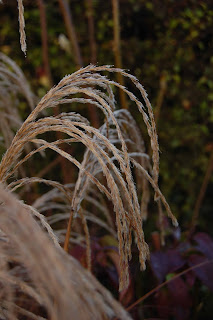At this time of the year, my friends mostly ask me what I do now winter is here after all, there are apparently no flowers around and no one wants to work outside in freezing temperatures. 'You must have nothing to do now,' they ask peering into my eyes and waiting for a deep gloomy recession-inspired response. Yes, it may seem a myth that garden designers only come out in spring or summer when the sun is shining (it does in winter), the birds are singing (they do all the year round) and plants are blooming (there are flowers in winter and of course, evergreens). My response is greeted with surprise and delight: I have plenty to do, thank you, and am very busy designing gardens, making gardens and writing about them. 'Oh, that's really good' is the usual stock reply to my explanation of what I actually do in the winter. I have no wish to hibernate in what is a busy time of the year and conditions outside make little or no difference (I always point out to clients that bad weather can cause delays at any time of the year).
The great appeal of implementing and building gardens in autumn and winter is the soil, it's so perfect for planting after being warmed up by the glories of summer allowing roots to put on good strong growth before the realities of severe weather really set in. When I was growing up, planting in autumn was a major part of the gardening year and the start of the season, not the end. Garden centres now are brimming with Christmas decorations, gifts and discounted garden furniture and alas, plants take a back seat to this dazzling array of consumer goodies. If you are planning to re-do areas of your garden, do think about getting this done now and not next spring: the obvious reasons are warm soil, but also some good deals to be had by buying bare root plants from herbaceous to hedging to trees, all far cheaper than container stock. Seek out little nurseries in your area or find those further afield by browsing on the web.
The Great Border in my own garden is now cleared of considerably overgrown shrubs and ready for marking out and liberal application of home grown compost to improve the heavy clay soil further. Some plants have already been bought including the delightful Miscanthus sinensis 'Kleine Fontane' with its silvery waterfall-like flower heads that last through the winter. Planted in various groups of five, they will eventually make a dense but pretty informal hedge, necessitating only a cut back to ground level in early March. Elsewhere, plants will be moved from other borders or divided to increase stock for the Great Border.
The fields surrounding the garden were, at the end of September, somewhat late in their harvest and the farmer has not yet ploughed them to make way for the next arable crop. This has delighted mass numbers of Greylag geese who enjoy browsing and feeding each evening in the temporarily fallow field. Their arrival at sundown and departure a little after sunrise each day is a joyful experience, a delight for the eyes and ears.
Friday, 19 November 2010
Subscribe to:
Post Comments (Atom)





No comments:
Post a Comment